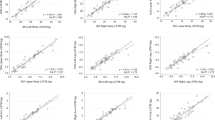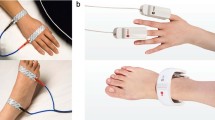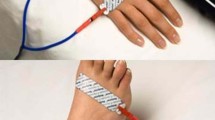Abstract
Background/objective
Knowing the distribution of lean soft tissue (LST) among the body segments is of relevance for optimizing athletic performance, monitoring response to training, and for evaluating injury risk. Bioelectrical impedance (BIA) is a portable, low cost, and easy technique to assess body composition. However, most equations used by BIA to predict LST are not specific for the athlete population. The aim of this investigation was to develop and validate equations to estimate dual-energy X-ray absorptiometry (DXA) appendicular LST of the arms and legs based on whole-body BIA in athletes.
Methods
Arms and legs LST were assessed by DXA and whole-body reactance (Xc) and resistance (R) were measured by BIA in athletes from various sports. Using measures of height, the resistance index (RI) (RI = height2/R) was calculated. Prediction equations were established using a cross-validation method where 177 athletes (2/3 of sample) were used for equation development and the remaining 88 athletes (1/3 of sample) were used for equation validation.
Results
The developed prediction equations were as follows: arm LST = 0.940 × sex (0 = male; 1 = female) + 0.042 × total body weight (kg) + 0.080 × RI + 0.024 × Xc − 3.927; leg LST = 1.983 × sex (0 = male; 1 = female) + 0.154 × total body weight (kg) + 0.127 × RI − 1.147. Both equations validated well for the arms (mean difference = 0.11 kg, R2 = 0.89, pure error (PE) = 0.61) and for the legs (mean difference = 0.05 kg, R2 = 0.81, PE = 1.93 kg). There were no differences (p > 0.05) in the mean observed and predicted LST for the arms and legs.
Conclusion
The developed BIA-based prediction equations provide a valid estimation of upper and lower body LST in athletes.
This is a preview of subscription content, access via your institution
Access options
Subscribe to this journal
Receive 12 print issues and online access
$259.00 per year
only $21.58 per issue
Buy this article
- Purchase on Springer Link
- Instant access to full article PDF
Prices may be subject to local taxes which are calculated during checkout

Similar content being viewed by others
References
Raymond CJ, Dengel DR, Bosch TA. Total and segmental body composition examination in collegiate football players using multifrequency bioelectrical impedance analysis and dual X-ray absorptiometry. J Strength Cond Res. 2018;32:772–82.
Gonzalez MC, Barbosa-Silva TG, Heymsfield SB. Bioelectrical impedance analysis in the assessment of sarcopenia. Curr Opin Clin Nutr Metab Care. 2018;21:366–74.
Bilsborough JC, Greenway K, Opar D, Livingstone S, Cordy J, Coutts AJ. The accuracy and precision of DXA for assessing body composition in team sport athletes. J Sports Sci. 2014;32:1821–8.
Fuller NJ, Laskey MA, Elia M. Assessment of the composition of major body regions by dual-energy X-ray absorptiometry (DEXA), with special reference to limb muscle mass. Clin Physiol. 1992;12:253–66.
Kyle UG, Bosaeus I, De Lorenzo AD, Deurenberg P, Elia M, Manuel Gomez J, et al. Bioelectrical impedance analysis-part II: utilization in clinical practice. Clin Nutr. 2004;23:1430–53.
Prior BM, Modlesky CM, Evans EM, Sloniger MA, Saunders MJ, Lewis RD, et al. Muscularity and the density of the fat-free mass in athletes. J Appl Physiol. 1985;90:1523–31.
Beaudart C, Bruyère O, Geerinck A, Hajaoui M, Scafoglieri A, Perkisas S, et al. Equation models developed with bioelectric impedance analysis tools to assess muscle mass: a systematic review. Clin Nutr. 2019;35:47–62.
Fornetti WC, Pivarnik JM, Foley JM, Fiechtner JJ. Reliability and validity of body composition measures in female athletes. J Appl Physiol. 1985;87:1114–22.
Stewart AD, Hannan WJ. Prediction of fat and fat-free mass in male athletes using dual X-ray absorptiometry as the reference method. J Sports Sci. 2000;18:263–74.
Yannakoulia M, Keramopoulos A, Tsakalakos N, Matalas AL. Body composition in dancers: the bioelectrical impedance method. Med Sci Sports Exerc. 2000;32:228–34.
Kyle UG, Bosaeus I, De Lorenzo AD, Deurenberg P, Elia M, Gomez JM, et al. Bioelectrical impedance analysis-part I: review of principles and methods. Clin Nutr. 2004;23:1226–43.
Andreoli A, Monteleone M, Van Loan M, Promenzio L, Tarantino U, De Lorenzo A. Effects of different sports on bone density and muscle mass in highly trained athletes. Med Sci Sports Exerc. 2001;33:507–11.
Lohman TG, Roche AF, Martorell R. Anthropometric standardization reference manual. Champaign, IL: Human Kinetics Books; 1988.
Matias CN, Júdice PB, Santos DA, Magalhães JP, Minderico CS, Fields DA, et al. Suitability of bioelectrical based methods to assess water compartments in recreational and elite athletes. J Am Coll Nutr. 2016;35:413–21.
Silva AM, Santos DA, Matias CN, Rocha PM, Petroski EL, Minderico CS, et al. Changes in regional body composition explain increases in energy expenditure in elite junior basketball players over the season. Eur J Appl Physiol. 2012;112:2727–37.
Sun S, Chumlea W. Statistical methods. In: Human body composition. Champaign, IL: Human Kinetics; 2005. p. 151–60.
Bland JM, Altman DG. Statistical methods for assessing agreement between two methods of clinical measurement. Lancet. 1986;1:307–10.
Lin LI. A concordance correlation coefficient to evaluate reproducibility. Biometrics. 1989;45:255–68.
Pichard C, Kyle UG, Gremion G, Gerbase M, Slosman DO. Body composition by X-ray absorptiometry and bioelectrical impedance in female runners. Med Sci Sports Exerc. 1997;29:1527–34.
Kim J, Wang Z, Heymsfield SB, Baumgartner RN, Gallagher D. Total-body skeletal muscle mass: estimation by a new dual-energy X-ray absorptiometry method. Am J Clin Nutr. 2002;76:378–83.
Pietrobelli A, Faith MS, Wang J, Brambilla P, Chiumello G, Heymsfield SB. Association of lean tissue and fat mass with bone mineral content in children and adolescents. Obes Res. 2002;10:56–60.
De Rui M, Veronese N, Bolzetta F, Berton L, Carraro S, Bano G, et al. Validation of bioelectrical impedance analysis for estimating limb lean mass in free-living Caucasian elderly people. Clin Nutr. 2017;36:577–84.
Esco MR, Snarr RL, Leatherwood MD, Chamberlain NA, Redding ML, Flatt AA, et al. Comparison of total and segmental body composition using DXA and multifrequency bioimpedance in collegiate female athletes. J Strength Cond Res. 2015;29:918–25.
Sergi G, De Rui M, Stubbs B, Veronese N, Manzato E. Measurement of lean body mass using bioelectrical impedance analysis: a consideration of the pros and cons. Aging Clin Exp Res. 2017;29:591–7.
Fields JB, Merrigan JJ, White JB, Jones MT. Body composition variables by sport and sport-position in elite collegiate athletes. J Strength Cond Res. 2018;32:3153–9.
Acknowledgements
The authors are thankful for all the athletes who contributed to this study.
Funding
Supported by the Fundação para a Ciência e Tecnologia, under Grant UIDB/00447/2020 to CIPER—Centro Interdisciplinar para o Estudo da Performance Humana (unit 447). PBJ is supported by the Fundação para a Ciência e Tecnologia under SFRH/BPD/115977/2016.
Author information
Authors and Affiliations
Contributions
LBS and AMS contributed to the conception and design of the study. IRC, JPM, PBJ, and MHR were responsible for data collection and acquisition. MHR was responsible for the data analysis and interpretation. MHR drafted the paper. LBS, AMS, IRC, JPM, PBJ, and MHR contributed to reviewing and editing the paper. LBS and MHR gave approval of the final paper and take responsibility for the integrity of the data and the accuracy of the data analysis.
Corresponding author
Ethics declarations
Conflict of interest
The authors declare that they have no conflict of interest.
Additional information
Publisher’s note Springer Nature remains neutral with regard to jurisdictional claims in published maps and institutional affiliations.
Rights and permissions
About this article
Cite this article
Sardinha, L.B., Correia, I.R., Magalhães, J.P. et al. Development and validation of BIA prediction equations of upper and lower limb lean soft tissue in athletes. Eur J Clin Nutr 74, 1646–1652 (2020). https://doi.org/10.1038/s41430-020-0666-8
Received:
Revised:
Accepted:
Published:
Issue Date:
DOI: https://doi.org/10.1038/s41430-020-0666-8
This article is cited by
-
Athletic bioimpedance-based equations underestimate fat free mass components in male elite soccer players: development and validation of new soccer-specific predictive models
Journal of Translational Medicine (2023)
-
Development and validation of bioelectrical impedance prediction equations estimating regional lean soft tissue mass in middle-aged adults
European Journal of Clinical Nutrition (2023)
-
Phase angle, muscle tissue, and resistance training
Reviews in Endocrine and Metabolic Disorders (2023)
-
Bioelectrical impedance analysis versus reference methods in the assessment of body composition in athletes
European Journal of Applied Physiology (2022)



